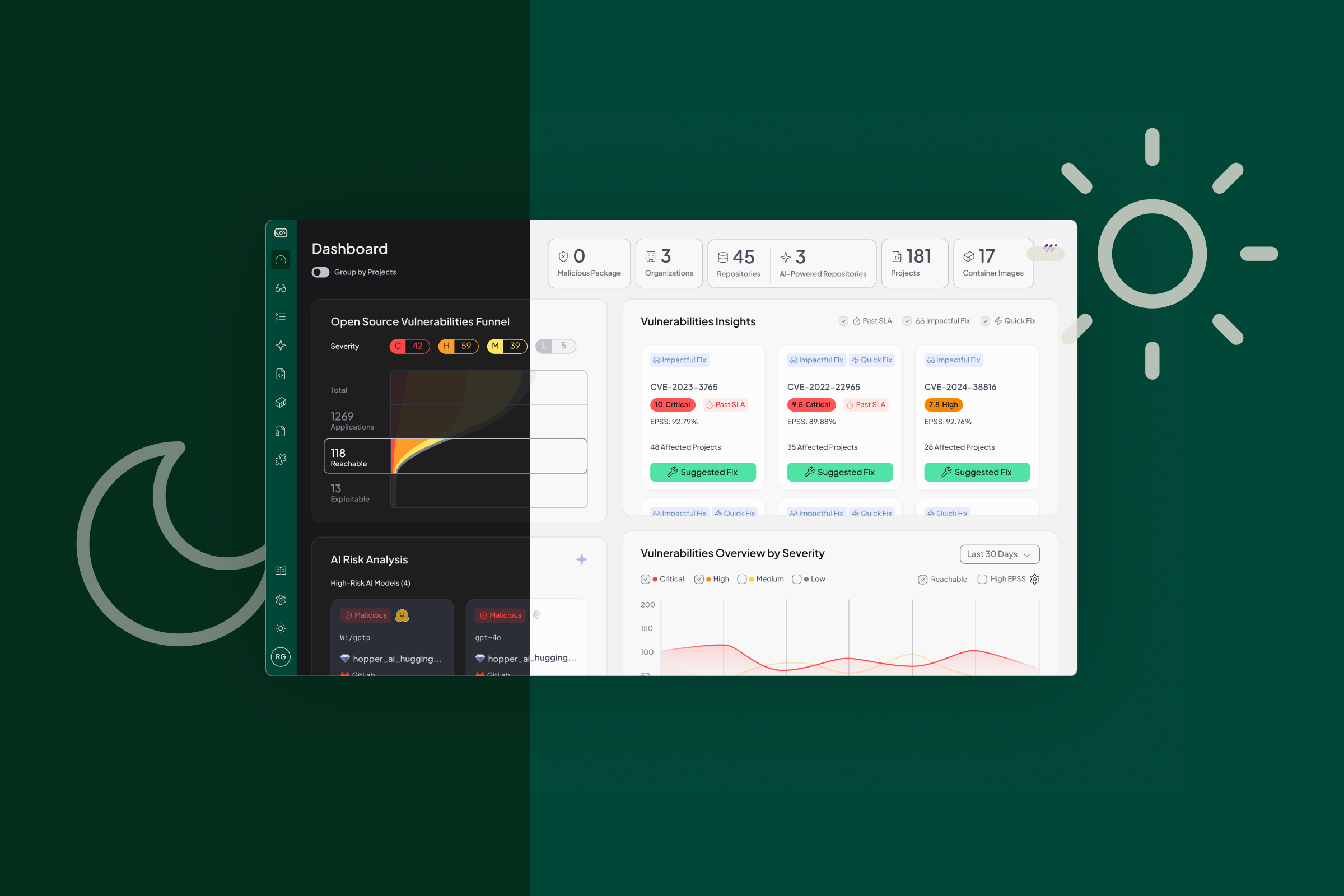Two Sides of the AppSec Coin
In application security, few comparisons are as common or as misunderstood as SCA vs SAST. Both are scanning tools. Both analyze code. Both generate findings that land on a developer’s desk. But they solve very different problems.
This difference matters even more in the age of AI-assisted development. Tools like GitHub Copilot, ChatGPT, and Cursor accelerate how teams write and reuse code, often introducing new dependencies at a pace that security teams struggle to track. The same speed that boosts productivity also expands the attack surface, increasing the likelihood of unvetted packages or insecure patterns entering production.
SCA monitors the open-source components that make modern software possible. SAST analyzes the proprietary code developers write, whether by hand or with AI assistance. Understanding how these tools complement each other is critical to keeping AI-driven development secure.
Confusing the two creates blind spots in coverage. This blog explains what each does, how attackers exploit their gaps, and why modern AppSec teams often start with SCA before layering in SAST, ultimately needing both to stay protected.
What is SCA (Software Composition Analysis)?
Software Composition Analysis (SCA) tools analyze applications for open-source components, which make up the majority of modern codebases. Intel’s The Careful Consumption of Open Source Software report notes that 77% of the code in audited commercial codebases was open source, with some studies placing the share as high as 70–90% of modern codebases. SCA helps you:
- Identify direct and transitive dependencies
- Map vulnerabilities (CVEs) to those dependencies
- Identify malicious packages
- Flag license compliance risks
- Generate SBOMs for regulators and customers
- Expedite remediation with personalized fix recommendations
SCA protects against known vulnerabilities and malicious packages in third-party software, such as the recent npm Shai-Hulud attack, Log4Shell in Log4j, Heartbleed in OpenSSL, and Spring4Shell in Spring Core.
Limitations of Traditional SCA
- Alerts on every CVE in every library, even if unused
- No exploitability context to prove whether the vulnerable function is executed
- Lack of evidence and context developers need for remediation, including call graphs and root cause analysis
- Creates alert fatigue and developer frustration
Modern SCA, like Hopper, uses function-level reachability analysis to address these gaps. By filtering out vulnerabilities that do not affect execution paths, teams can cut more than 90% of irrelevant alerts and focus on real risks. Beyond prioritization, modern tools also provide the evidence developers need to act, including direct links to the affected source code, call graphs that illustrate execution paths, and root cause tracing that shows exactly where the issue originates.
What is SAST (Static Application Security Testing)?
Static Application Security Testing (SAST) scans proprietary, first-party source code to detect insecure patterns introduced by developers. Common issues include:
- SQL injection
- Cross-site scripting (XSS)
- Unsafe deserialization
- Buffer overflows
- Hardcoded secrets
SAST protects against custom logic flaws unique to your codebase, risks that SCA cannot detect. While SCA findings map to confirmed vulnerabilities (CVEs), SAST findings surface potential vulnerabilities based on pattern analysis. Both are essential, but they represent very different layers of assurance.
Limitations of SAST
- High rate of false positives when insecure patterns are flagged without context
- Long scan times that disrupt developer workflows
- Ongoing tuning needed to fit organizational coding standards
- Findings that do not always translate into exploitable risk
SCA vs SAST: Key Differences
How Attackers See the Difference
Attackers do not care whether the flaw comes from open-source or proprietary code. They care about the easiest way in.
- In a supply chain exploit, they target a known OSS vulnerability like Log4j that is widely used across industries.
- In a custom code exploit, they look for flaws in unique business logic such as weak input validation that enables SQL injection.
Both paths are actively used by attackers. Covering one but not the other leaves a large part of your application exposed.
How Remediation Differs
Both SCA and SAST findings require code changes, but the nature of those changes differs.
- SCA fixes involve modifying dependency references in code, upgrading, replacing, or removing vulnerable packages, which is often faster but can affect build stability.
- SAST fixes require rewriting proprietary logic, refactoring functions, or hardening code paths, which can take more time and testing.
This difference affects developer workload, mean time to remediation, and the skill sets required for effective response.
Why You Need Both
Applications today are built with a mix of open-source and custom code. Industry research suggests 70–90% of applications are open source, while 20-40% are proprietary. Both categories are frequent targets of real-world attacks.
- Only SCA? You’ll miss flaws in custom code.
- Only SAST? You’ll miss supply chain risk.
Full coverage requires both working in parallel.
The Developer Experience (DevEx) Problem
Even with both tools in place, developer trust is a common pain point. Traditional SCA overwhelms teams with irrelevant CVE alerts. SAST produces false positives that may not represent exploitable risks.
This leads to wasted cycles, missed SLAs, and friction between security and engineering. The future of both categories lies in precision and evidence-based findings.
Hopper’s Lens on SCA
Hopper addresses the weaknesses of traditional SCA by focusing on accuracy and developer trust:
- Function-level reachability analysis filters out 93% of irrelevant alerts
- Automatic asset discovery ensures new repositories and apps are always covered
- Evidence-based remediation guidance (call graphs, fix effort estimates) makes tickets actionable
- Integration-ready design ensures findings flow into workflow tools without duplication
- Agentless, read-only deployment delivers value within minutes and requires no CI/CD changes
Rather than being a general security platform, Hopper is best-in-class for OSS risk. It strengthens the open-source layer of an AppSec program that also includes tools like SAST, secrets management, IaC, and vulnerability disclosure programs, making the entire process more accurate and developer-friendly.
Covering Both Sides of the Attack Surface
SCA and SAST are not competing solutions. They are complementary.
- SCA protects against vulnerabilities inherited from open-source software.
- SAST protects against vulnerabilities introduced in proprietary code.
- Together they create the complete picture of application risk.
The challenge is not whether to choose one or the other. It is to implement them in a way that reduces noise, accelerates remediation, and earns developer trust.
Hopper ensures that the SCA side of this equation finally works as intended. By eliminating irrelevant alerts and providing evidence-based guidance, it transforms SCA from a noisy compliance checkbox into a reliable, developer-friendly security control.
FAQs
Is SCA the same as SAST?
No. SCA analyzes open-source dependencies. SAST scans proprietary code. They solve different problems.
Do I need both?
Yes. Ignoring one leaves part of your application unprotected.
Which should I implement first?
It depends. If your stack relies heavily on open source, start with SCA. If you maintain large amounts of custom code, start with SAST. Most enterprises need both.
Why do developers dislike these tools?
Because of noise. Traditional tools overwhelm teams with irrelevant or non-actionable findings. Modern approaches reduce noise by focusing only on exploitable risks.
Can ASPM replace SCA or SAST?
No. ASPM organizes findings from tools like SCA and SAST but does not generate vulnerability data itself.






